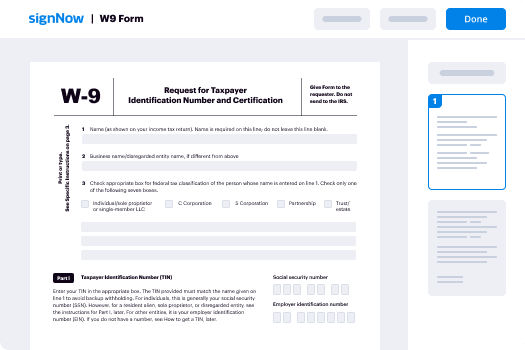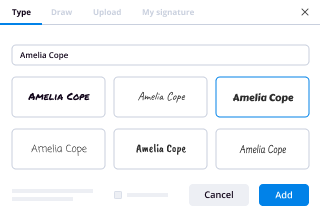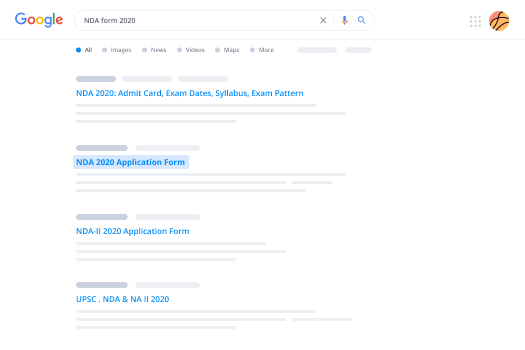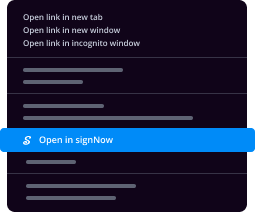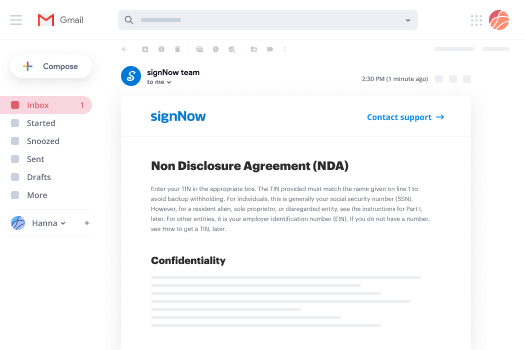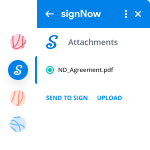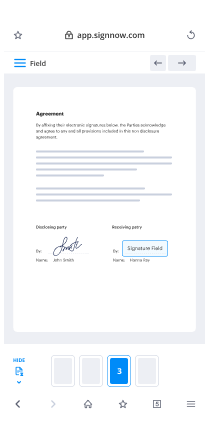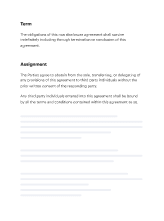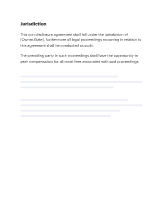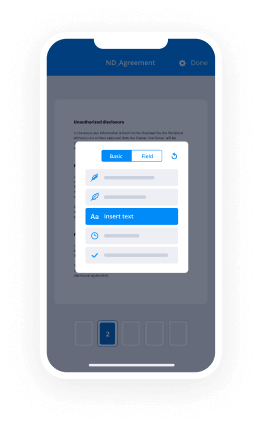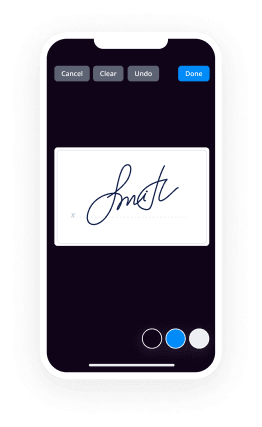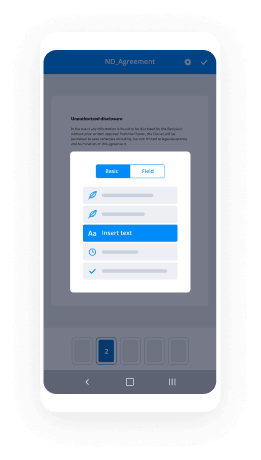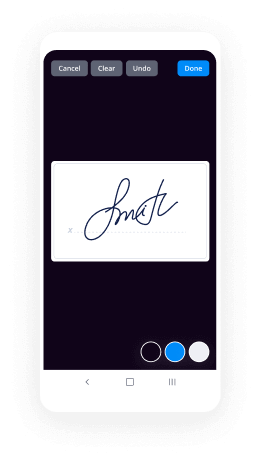Try Seamless eSignatures: How to Use an Electronic Signature in Word
- Quick to start
- Easy-to-use
- 24/7 support
Simplified document journeys for small teams and individuals




We spread the word about digital transformation
Why choose airSlate SignNow
-
Free 7-day trial. Choose the plan you need and try it risk-free.
-
Honest pricing for full-featured plans. airSlate SignNow offers subscription plans with no overages or hidden fees at renewal.
-
Enterprise-grade security. airSlate SignNow helps you comply with global security standards.







Quick-start guide on how to use an electronic signature in Word
The airSlate SignNow eSignature solution is ready to substitute your handwritten autograph and improve almost any paper-driven, manual procedures. Signing documents electronically helps save time, cuts expenses, and gives you the flexibility to approve deals and official forms from anywhere and anytime, on any device. Read on to learn about tips on how to begin enhancing your approval workflows and sign and send documents for signature electronically.
Complete the following steps below to learn how to use an electronic signature in Word:
- Open your web browser and go to signnow.com.
- Sign up for a free trial run or log in with your electronic mail or Google/Facebook credentials.
- Click on User Avatar -> My Account at the top-right area of the webpage.
- Customize your User Profile with your personal information and altering configurations.
- Make and manage your Default Signature(s).
- Go back to the dashboard webpage.
- Hover over the Upload and Create button and select the needed option.
- Click on the Prepare and Send key next to the document's name.
- Input the name and email address of all signers in the pop-up window that opens.
- Use the Start adding fields menu to proceed to modify file and self sign them.
- Click SAVE AND INVITE when you're done.
- Continue to configure your eSignature workflow using extra features.
It can't get any simpler to learn how to use an electronic signature in Word than it is with airSlate SignNow. Register your profile, modify and sign templates, ask for signatures, and track every activity taken to your documents.
How it works
Rate your experience
What is an electronic signature in Word?
An electronic signature in Word is a digital representation of a person's intent to agree to the contents of a document. It serves the same purpose as a handwritten signature but is created and stored electronically. This method allows users to sign documents quickly and securely, enhancing the efficiency of workflows. Electronic signatures are legally recognized in the United States under the ESIGN Act and the Uniform Electronic Transactions Act, making them a valid option for various types of agreements and contracts.
Steps to complete the electronic signature process in Word
Using an electronic signature in Word involves a few straightforward steps. First, open the document you wish to sign. Next, navigate to the area where you need to place your signature. You can use airSlate SignNow to upload the document and initiate the signing process. Once uploaded, you can fill out any necessary fields and insert your electronic signature. After completing the document, you can send it for signature to others or save it for your records. This process streamlines the signing experience, ensuring that all parties can access and complete the document efficiently.
Legal use of electronic signatures in Word
Electronic signatures are legally binding in the United States, provided they meet certain criteria. To ensure compliance, the signature must be associated with the signed document and must reflect the signer's intent. It is essential to maintain a secure and verifiable process when using electronic signatures. This includes using platforms like airSlate SignNow, which provide audit trails and authentication features. Familiarizing yourself with state-specific regulations can also help ensure that your electronic signatures are valid and enforceable.
Security and compliance guidelines for electronic signatures
When using electronic signatures, security and compliance are paramount. It is important to choose a reliable platform like airSlate SignNow that offers encryption and secure storage for signed documents. Ensure that the electronic signature process includes identity verification measures to protect against unauthorized access. Compliance with regulations such as the ESIGN Act and the Uniform Electronic Transactions Act is also crucial. Regularly reviewing security protocols and staying informed about legal updates can help maintain the integrity of your electronic signature practices.
Documents you can sign electronically in Word
Many types of documents can be signed electronically using Word and platforms like airSlate SignNow. Common examples include contracts, agreements, forms, and letters. Businesses often utilize electronic signatures for HR documents, sales contracts, and legal agreements. The flexibility of electronic signatures allows for efficient management of various document types, reducing the need for physical paperwork and streamlining the signing process.
Sending and signing methods for electronic signatures
There are several methods to send and sign documents electronically. Users can access airSlate SignNow via web browsers, mobile devices, or dedicated applications. This versatility allows for signing on the go, making it convenient to manage documents from anywhere. Once a document is ready, it can be sent for signature via email or shared directly within the platform. Recipients can easily review and sign documents, ensuring a quick turnaround and efficient workflow.
-
Best ROI. Our customers achieve an average 7x ROI within the first six months.
-
Scales with your use cases. From SMBs to mid-market, airSlate SignNow delivers results for businesses of all sizes.
-
Intuitive UI and API. Sign and send documents from your apps in minutes.
FAQs
-
What is an electronic signature and how does it work in Word?
An electronic signature is a digital version of a handwritten signature that can be used to sign documents electronically. To learn how to use an electronic signature in Word, you can insert a signature line or use a digital signature feature, allowing you to sign documents securely and efficiently.
-
How can I create an electronic signature in Word?
To create an electronic signature in Word, you can use the 'Draw' feature to sign directly on the document or insert a scanned image of your signature. Additionally, using tools like airSlate SignNow can simplify the process of how to use an electronic signature in Word by providing templates and easy integration.
-
Is there a cost associated with using electronic signatures in Word?
While Microsoft Word itself does not charge for electronic signatures, using third-party services like airSlate SignNow may involve subscription fees. These services often provide enhanced features and security, making it easier to understand how to use an electronic signature in Word effectively.
-
What are the benefits of using electronic signatures in Word?
Using electronic signatures in Word streamlines the signing process, reduces paper waste, and enhances document security. By understanding how to use an electronic signature in Word, you can save time and improve workflow efficiency for your business.
-
Can I integrate airSlate SignNow with Microsoft Word?
Yes, airSlate SignNow offers seamless integration with Microsoft Word, allowing you to manage your documents and signatures in one place. This integration simplifies how to use an electronic signature in Word, making it easier to send and sign documents directly from the application.
-
Are electronic signatures legally binding in Word?
Yes, electronic signatures created in Word using compliant tools like airSlate SignNow are legally binding in many jurisdictions. Understanding how to use an electronic signature in Word ensures that your signed documents meet legal standards and can be enforced in court.
-
What types of documents can I sign electronically in Word?
You can sign a variety of documents electronically in Word, including contracts, agreements, and forms. Knowing how to use an electronic signature in Word allows you to handle different document types efficiently, ensuring a smooth signing process.





























